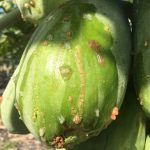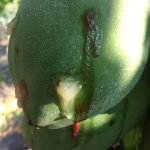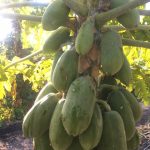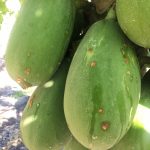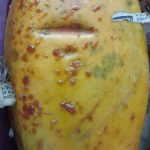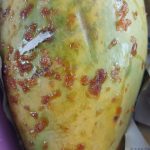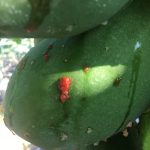Papaya Meleira Virus
Introduction
– This disease was first reported in Brazil in the late 1980s.
– It is responsible for the loss of crops up to 100%.
– In 2012, it was detected in 8 states of Mexico.
Main symptoms of Virus Meleira
– Fruits or wounds present an abundant exudation of crystalline and liquid latex, giving them a sticky appearance due to their low coagulation.
– The latex oxidizes taking colors from straw yellow, orange, red to finally turning black, which is the most common symptom to identify the Meleira virus.
– It is also common to locate dark spots of oxidized latex on the edges of leaves, petioles and buds.
– In the epidermis of the fruit mapping type spots are formed, the pulp also presents a type of spots, causing it to lose its commercial value.
Vectors
Agricultural tools to carry out cultural work in the orchards, since the meleira virus particles are found in the latex, extract of leaves and fruits, so the work tools can spread the virus if they are not disinfected.
Insects of the order Hemiptera such as whiteflies, aphids and leafhoppers can transmit Meleira since the virus particles persist in their biting-sucking mouthparts throughout the insect’s life cycle.
Papaya seeds also harbor meleira virus particles in embryos, which is why they are also considered vectors.
Recommendations
culture control:
Use certified seed or seed from the fruits of healthy plants.
Use virus-free seedlings.
Immediate elimination of papaya plants that show symptoms, however minimal they may be. As well as old plantations that are no longer in production.
Keep the garden clean of weeds, to avoid the formation of vector insect colonies.
Meleira is processed by contact, so it is very important to disinfect agricultural tools, with a 1:10 solution of sodium hypochlorite.
vector management
Biologic control:
Insect vectors can be controlled using entomopathogenic fungi such as Beauveria Sp., and Metarhizium Sp.
Endemic predatory insects such as ladybugs and lacewings also help control insect vectors.
Biorational Control:
Using potassium salts of fatty acids and extracts of garlic and capsaicin repel the vector insects of the meleira virus, when the populations are not very large.
Chemical Monitoring and Control:
Before making the decision to make any chemical application, it is important to have carried out a thorough “Monitoring of vector insects” such as leafhoppers, whiteflies, aphids, etc. Since good monitoring on time can prevent us from having to apply insecticides in a general way in the papaya plantation.
Monitoring must be carried out both in the papaya crop and in weeds (weeds) that grow on the edges of the orchard, since it is here where the greatest pressure from sucking insects is found.
Monitoring can be reinforced with yellow traps for leafhoppers and aphids.
Through monitoring it will be known where the presence of vector insects is, once the inoculum is located, it is recommended to select a systemic insecticide to make a drench application to about 20 plants along the row, and repeat in about 3 continuous rows, to make a barrier where the vector insects die and do not enter the plantation spreading the disease. It is important when selecting the systemic insecticide that the maximum residue limits are taken care of, that is to say, paying attention to the maximum residue concentrations of the active ingredient so that there are no problems with the harvest.
- Daño Meleira
- Daño Meleira
- Daño Meleira
- Daño Meleira
- Daño Meleira
- Daño Meleira
- Daño Meleira
